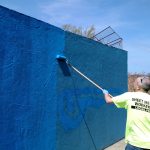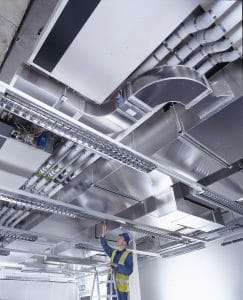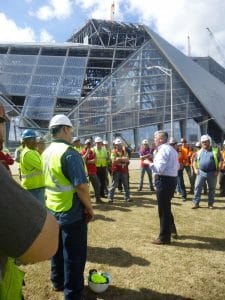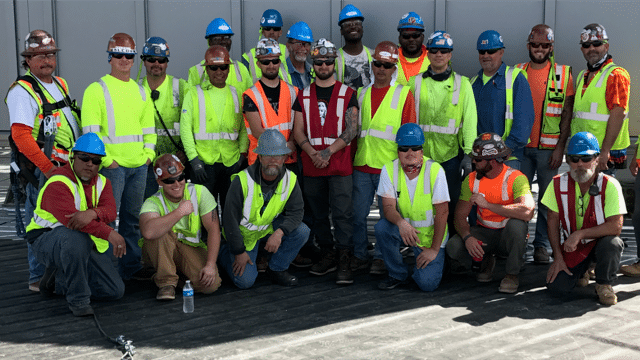The new nonpartisan group, ReBuild USA, recently announced its launch with a short video highlighting the threat to America’s people and economy if comprehensive efforts are not taken immediately to address the nation’s infrastructure needs.
The group is backed by all 14 building-trades belonging to the North American Building Trades Union (NABTU). According to NABTU President Sean McGarvey: “ReBuild USA will hold elected officials of both parties accountable for the promises they made in recent elections to fix our disastrous infrastructure and put Americans back to work. Our members and leadership are united also in supporting ReBuild USA’s effort to guarantee pro-worker protections, including prevailing wage standards at both the federal and state levels.”
Author: paul
At SMOHIT the mission, in addition to their health screening program, is to provide industry-leading health and safety solutions that minimize occupational illnesses and injuries for members in the sheet metal industry.
As an added benefit of membership, they are hosting a little friendly competition — a STEPS Challenge.
The top 15 individuals who have the highest number of steps for six weeks – June 15th to July 31st – will win big. Visit http://www.smohit.org/stepschallenge for more info.
Michael Gregory Olleck, a long time SMART TD member lost his life on June 10th, 2017 while at work. Mike enlisted in the United States Marine Corps soon after high school. He then worked for the LIRR for 17 years first as a trackman and then as a track foreman. He lost his life tragically in an accident while at work. His union brothers and sisters would like to help his devastated family as much as possible.
According to Anthony Lavoratore, SMART TD Local 29 General Vice President, “Mike was a great man and a good friend. He has helped so many of his fellow members through the years. This is something we would like to do to pay him back for all he has given us through the years.”
Below is a link to the GoFundMe account set up to assist his family: https://www.gofundme.com/michael-olleck-and-family

On a Saturday in April, Local 40 volunteers helped spruce up the West Haven Little League baseball & softball fields at Morse Park. Local 40 helped clean, power wash, scrape and paint the fields in preparation for the new season.
“We’re in the neighborhood just like everyone else, and playing a positive role pays big dividends in the long term,” said Local 40 Business Manager Dave Roche.
“Giving back and leading in our local areas builds the good will that opens people’s hearts and minds to partnering with us in developing the kind of good-paying middle class jobs we’re trying to build. It’s a win-win for everyone.”
A new study has found that construction workers across the southern United States receive little to no employment benefits and have relatively low pay.
The Workers Defense Project report found that 40% of construction workers in Houston had no health insurance, retirement savings, paid vacations or sick leave. More than 30% were not offered breaks during the day and reported that their employer did not provide drinking water on the job. Only 5% of the 1,435 workers interviewed in six Southern states said workers’ compensation covered the cost of their work injuries, and 57% said they earned less than $15 an hour.
The results of this study reinforce the story of the “low road” business model that has taken root in the U.S. construction industry, particularly across the southern U.S. which has become predominantly right to work (for less). On one hand, contractors express their concern about a skilled-labor shortage, but on the other do little to address it in their business practices.
Across the nation, average hourly wages for American construction workers, adjusted for inflation, have been in decline since the late 1970s.
The Workers Defense Project report underscores the fact that, at least in the South, many companies aren’t making the necessary changes in compensation and workplace culture to be an attractive option for new entrants into the skilled construction trades. All too often, the short-sighted focus is to target labor as a place to cut costs in order to see a bigger profit or to win work as low bidders. This creates a race to the bottom which sees not only deteriorating jobsite conditions but also a substandard product once complete on many non-union sites.
SMART TD brother and conductor Mike Case was tragically the victim of a shooting by a disgruntled passenger while working Train 4 in Naperville, Ill. The father of four suffered injuries to his liver, pancreas and parts of his intestines from the single gunshot wound, according to a hospital spokesperson from Edward Hospital in Naperville.
Brother Case has been part of the Amtrak family for quiet some time. According to a GoFundMe site set up to assist both him and his family, “Anybody who knows him knows he is a huge jokester and a great guy.”
Those interested in helping him and his family during the very difficult time are encouraged to visit this GoFundMe site that was set up by his co-workers. No amount is too small and everything is greatly appreciated.
Bring your enthusiasm, optimism, and great ideas, because the 2018 Partners in Progress Conference is an opportunity you don’t want to miss.
Featuring an outstanding educational program, fresh ideas, and constructive conversation, the 2018 conference will take place Feb. 13-14, 2018, in Orlando, Fla. The event will set the stage for the exchange of thoughts and establish a dialogue between labor and management to better understand the market and our competitive strengths.
The 2018 conference’s theme is “Communicate, Commit, Deliver,” because we know together we are stronger when these values happen. Those who have attended previous conferences know how beneficial this program can be. This year will be no different. Mark your calendar now and plan to attend.
Strengthen relationships, explore new markets
The 2018 conference also offers you the unique opportunity to exchange ideas with other chapters and locals across the country. You will gain the tools to strengthen or establish your local labor/management relationship, improve communication with workers, labor, and management, and explore ways to sustain and expand markets.
Together we will address complex industry problems and examine solutions. The exceptional educational program will foster a spirit of cooperation between labor and management. Enthusiasm, optimism, and great ideas will be the by-products of these efforts.
The 2018 conference will be held Feb. 13-14, 2018 at the recently renovated Hilton Buena Vista Resort in Orlando, Fla. The program has been completely restructured to maximize your learning opportunities.
Watch the Partners in Progress (link to: http://www.pinp.org/) and SMACNA (https://www.smacna.org) websites for more details on the program.

Workers performing construction, renovation or maintenance activities in a health care environment may not take the Hippocratic Oath, but undoubtedly they do not want to harm anyone either. And, as we see construction projects in the health care industry continue to outpace construction in other sectors, the oath must extend beyond the traditional medical community.
Understanding the need for construction workers in the health care industry to be properly trained and certified, NEMIC will introduce six new certifications over the next two years that cover the broad range of tasks, techniques and skills needed for work that meets the industry’s Infection Control Risk Assessment (ICRA) protocols.
Safe work near active areas
With so many facilities expanding and/or renovating, ICRA aims for patient safety when work is being done near or even directly adjacent to active treatment areas.
The first certification, ICRA/Certified Healthcare Environment Worker, introduced in late 2016, is the basis upon which the subsequent certifications will build. The healthcare environment worker will understand the basics of infection control and the role of the construction worker in preventing the spread of infection. The certified healthcare environment worker is trained and certified in ICRA policy and protocol.
NEMIC is expected to institute two additional certifications in 2017, with the final three certifications to be implemented in 2018.
The risks to patient health—and to facilities’ insurance costs—make ICRA capability a fast-growing requirement for contractors and workers alike.
Each of the certifications requires members to attend courses developed and taught by the ITI and pass a test to receive their certification. Those who become certified will receive a photo ID card that shows his or her certification type, certification number and the date the current certification expires. All certifications must be renewed every two years.
“These certifications open up a new market share for our SMART signatory contractors and members working in health care facilities,” said Dave Bernett, NEMIC’s Administrator. “With an aging population, the nation’s hospitals, nursing homes, acute care facilities, general medical facilities and even local drug store pharmacies that administer flu shots all are going to be expanding and modernizing.
“Because these facilities have mandates in place from the Centers for Medicare and Medicaid that affect their budgets, having a certified workforce protects the facilities’ bottom line and the patients they care for.”
[text subhead]
ICRA certs give contractors, members edge to win work
NEMIC Director of Certification Gary Andis explained that the new certifications go far beyond what any other group offers workers in the health care construction industry.
“We are currently the only group that requires our members take—and pass—a test to assess knowledge at the end of the training program,” Andis said. “The test isn’t easy—only about 62 percent of participants in the pilot program passed—but the rigor of the program will ensure that we are producing highly qualified technicians and supervisors with the right skills for our market.”
Health care facilities are unique in that many operate 24 hours a day, 365 days a year. Performing maintenance, construction and renovation projects in that environment poses concerns beyond your traditional facility. Health care-associated infections (HAIs) are especially concerning.
The Centers for Disease Control and Prevention (CDC) estimates that every year some 648,000 patients in the United States develop infections during a hospital stay, and about 75,000 of those patients die. Due to the vast number of HAIs recorded, the Centers for Medicare and Medicaid have implemented a strategy of withholding reimbursement to health care facilities for failure to properly institute infection-control measures—and each year, the percentage withheld increases.
While it is impossible to measure the exact number of patients that developed HAIs from facility-related construction or maintenance activities, a 2011 survey analysis by the Centers for Medicare and Medicaid concluded that each year an estimated 5,000 patients develop an HAI that ultimately leads to death as the result of ongoing construction.
Sector grows by the billions
In the first half of 2016, construction in the health care industry rose by 2.2 percent, or $19.6 billion, from the same period the previous year. Economists from the American Institute of Architects predict that 2017 will see that number double.
“The work is emerging and the need will continue to grow as baby boomers age and their health care needs expand,” Andis said. “NEMIC and the ITI are creating new opportunities to put members to work, and this certification and the subsequent certifications we are working on will ensure that our contractors working in the health care market have access to employees that have proven they understand the intricacies of ICRA.
“Receiving a certificate for sitting through an eight-hour class doesn’t prove you absorbed the information. But, passing a rigorous test shows you understand and grasp the subject matter.”
The Fourth Annual National Safety Stand-Down to Prevent Construction Falls is happening now. Across the country, companies are pausing work for toolbox talks, equipment audits, and educational activities addressing this hazard. CLICK HERE for a video introduction. You can join the Center to Protect Worker Rights (CPWR) at 2 pm EST for their webinar on the latest research on fall fatalities and fall prevention from their CPWR Quarterly Data Report. This 30 minute webinar will review the main findings of the report, and highlight the need to reduce fall injuries and fatalities in construction and the importance of the Stand-Down and the overall CPWR-NIOSH-OSHA National Fall Prevention Campaign.
A Union president’s job always involves a lot of travel, to meet with contractors, industry leaders, elected officials, and with Union officers, funds staff, and many others across the U.S. and Canada.
But just after t
These pages cover just a few of these early sessions, in Mississippi, Florida, and Georgia. There have been others, like at Cove Point in Maryland where a number of SM Local 100 members were praised by management at API for their valuable work at the facility. There will be many more.
The reception from members he has spoken with and the input he has brought back from those visits have made Sellers more committed than ever to continue the ongoing gatherings.
His busy travel schedule takes time—but also takes him to place
s where he can connect with members: construction sites, rail yards, fabrication shops, production plants, transit depots, and others.
Sellers, a second-generation sheet metal worker, has felt increasing pride as he speaks with members.
“I am always energized by our members,” Sellers noted. “They show me their professionalism, their union spirit and—what I’m really after—their ideas for making things better on the job, in our Union and in their own communities.
“I look forward to the opportunities I’ll have all year to take a minute with our membership and listen to your thoughts and views. That kind of informed input is what I value most to make our Union work for all of us.”
